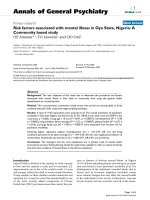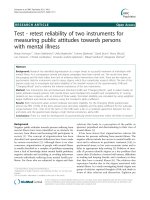Public attitudes, stigma and discrimination against people with mental illness
Bạn đang xem bản rút gọn của tài liệu. Xem và tải ngay bản đầy đủ của tài liệu tại đây (122.93 KB, 19 trang )
12
Public attitudes, stigma and discrimination
against people with mental illness
Graham Thornicroft and Aliya Kassam
Introduction
Many people with mental illness are subjected to systematic disadvantages in most
areas of their lives. Why should this be so? What can we learn from other
conditions whose image may have changed over time? Should we fatalistically
accept that these processes of exclusion are somehow tribal, deeply rooted and
resistant to change? Or is it realistic to see stigma and discrimination as cultural
constructions, which we can collectively change if we understand them clearly and
commit ourselves to tackle them? These issues are at the core of this chapter.
The starting point: stigma
The unavoidable starting point for this discussion is the idea of stigma. This term
(plural, stigmata) was originally used to refer to an indelible dot left on the skin after
stinging with a sharp instrument, sometimes used to identify vagabonds or slaves
(Cannan, 1895; Hobbes of Malmesbury, 1657). The resulting mark led to the
metaphorical use of ‘stigma’ to refer to stained or soiled individuals who were in
some way morally diminished (Gilman, 1985). In modern times stigma has come to
mean ‘any attribute, trait or disorder that marks an individual as being unacceptably
different from the ‘normal’ people with whom he or she routinely interacts, and that
elicits some form of community sanction’ (Goffman, 1963; Scambler, 1998).
Stigma and physical conditions
While this chapter is concerned specifically with people who have diagnoses
of mental illnesses, the stigma concept has also been used extensively for some
particular physical conditions (Mason, 2001). What can we learn from this work?
Society and Psychosis, ed. Craig Morgan, Kwame McKenzie and Paul Fearon. Published by Cambridge
University Press. # Cambridge University Press 2008.
People with HIV or AIDS have perhaps been most often described in recent years
as suffering from the effects of stigmatisation (Klitzman and Bayer, 2003). The
prominent themes in these discussions have been how far the individuals con-
cerned are responsible (and, therefore, to blame) for their status (e.g., Kelly et al.,
1987), and the balance between the need to protect the public health and to respect
the confidentiality and human rights of people with this diagnosis (Goldin, 1994;
Herek et al., 2003). It is particularly important to note that during the 1990s
inaccurate beliefs about the risks posed by casual social contact with people with
HIV and AIDS increased, as did the belief that people with AIDS deserve their
illness, but overt expression of stigma declined through this decade (Herek et al.,
2002). In other words, it was not necessary for factual knowledge or moral
attitudes to improve for behaviour to change in a positive way (see Box 12.1).
Degrees of rejection
What do we know about how far stigma applies to people with mental illnesses
compared with other conditions? In brief, very little. Most of the literature on
stigma and discrimination focuses on: theories of psychological processes, attitude
scales, opinion surveys, links with violence and portrayals in the media.
Comparative stigma is one of the many areas about which very little has been
written (Weiss, 2001).
There have been several studies of social distance (e.g., Corrigan et al., 2001).
These typically present a vignette or a hypothetical scenario of a person with a
particular condition, and ask whether you would want to live next door to that
person, whether you would let that person act as a childminder to your children or
whether you would allow your son or daughter to marry such a person (e.g.,
Angermeyer et al., 2003). A series of such surveys in Germany found high levels of
social distance expressed towards people with schizophrenia, and even higher
Box 12.1 Service user accounts (1)
‘Perhaps the reason that science struggles in the face of mental illness is that the
illness is somehow bound up with their personality. This I think is dead central to the
stigma issue. If the illness is in some way related to your personality, then haven’t you
in some way brought it on yourself? If your personality has grown to become bound
up with illness, then why would anyone want to be around such an influence? Based
on this, it’s no wonder that people try to steer clear of the mentally ill.’ Robert
‘Often I have heard comments, either said to me or about people with depression, as
‘lazy’. I was constantly tired and at low periods I would take to my bed and isolate
myself from the outside world.’ Tania
180 G. Thornicroft and A. Kassam
levels to those with alcohol dependence (Angermeyer and Matschinger, 1997).
A revealing US study asked employers about job-offer intentions, and found that
ex-convicts were seen to be more acceptable than people with mental illness, and
the only group less favoured by employers were those with tuberculosis (Brand, Jr
and Clairborn, 1976). Such high levels of concern were also found in a sample of
over 1500 members of the general UK population who were asked about their
attitudes to people with five different conditions. Their concern levels were: stress
or depression, 34%; epilepsy, 19%; heart attack, 17%; facial disfigurement, 9%; or
use of a wheelchair, 4% (Jacoby et al., 2004).
In a very detailed comparison in Kansas, over 100 undergraduate psychology
students were asked to compare 66 different medical conditions in 13 dimensions,
including social distance. Overall, five of these dimensions predicted rejection:
severity of the condition, contagiousness, behavioural causality, availability and
sexual transmission, where the last four were all closely linked to personal control.
In other words, how far is the individual directly or indirectly at fault in developing
the condition? In an important conclusion, the authors stated, ‘Severity and
behavioural causality account for a significant amount of the socially shared
representation of what makes an illness stigmatisable.’ (Crandall and Moriarty,
1995, p. 74.) Care is needed here. It may not necessarily follow, for example, that
emphasising the biological basis of mental illnesses will reduce stigma by reducing
blame for a condition over which the person affected is assumed to have little
responsibility. Indeed a German survey found the opposite (Dietrich et al., 2004).
Stigma can also be assessed indirectly. One particularly intriguing approach is to
see whether people with a particular physical condition are treated differently if
they do or do not also have a diagnosis of mental illness (Murray and Lopez, 1996).
For people with diabetes, for example (which is more common in people treated
with some types of antipsychotic medication), the quality of care was assessed by
five key indicators: annual foot inspection, foot-pulse examination, foot sensory
examination, retina examination and a specific blood test (glycated haemoglobin).
The study found that people with mental illness (particularly substance misuse)
were less likely to receive these recommended health checks (Desai et al., 2002a).
In terms of treatment for heart conditions, most (but not all (Desai et al.,
2002b)) studies also show that people with mental illness receive inferior physical
healthcare. For example, careful examination of the treatment records of over
110 000 people who had acute in-patient care in the USA found that, compared
with those without a mental illness, people with such conditions were prescribed
appropriate medications less often (Druss et al., 2001) and also received fewer
surgical procedures (Druss et al., 2000). These care deficits were associated with
higher mortality rates after heart attacks (Druss et al., 2001). This strongly suggests
that some form of direct or indirect discrimination is in operation.
181 Public attitudes, stigma and discrimination
Understanding stigma
There is now a voluminous literature on stigma (e.g., Corrigan, 2005; Goffman,
1963; Heatherton et al., 2003; Link et al., 1989; Mason, 2001; Pickenhagen and
Sartorius, 2002; Sartorius and Schulze, 2005; Wahl, 1999). The stigma of mental
illness is the subject of many hundreds of scientific papers (Pickenhagen and
Sartorius, 2002). The most complete model of the component processes of stig-
matisation has four key components (Link and Phelan, 2001): (1) labelling, in
which personal characteristics are signalled or noticed as conveying an important
difference; (2) stereotyping, which is the linkage of these differences to undesirable
characteristics; (3) separating, the categorical distinction between the mainstream
or normal group and the labelled group as being in some respects fundamentally
different; and (4) status loss and discrimination, i.e., devaluing, rejecting and
excluding the labelled group. Interestingly, more recently, the authors of this
model have added a revision to include the emotional reactions which may
accompany each of these stages (Link et al., 2004).
Another way to look at stigma is to think of six dimensions along which it can vary:
(1) concealability or visibility, (2) its course over time, (3) the strain on interpersonal
relationships, (4) related aesthetic qualities,(5)thecauseofthedisordersand(6)the
peril or danger to others associated with the condition (Jones et al., 1984).
Shortcomings of stigma models
A number of features have limited the usefulness of these theories. First, while
these processes are undoubtedly complex, the approach taken by academics has
been dominated by those within social psychology or sociology (Corrigan, 2005;
Goffman, 1963; Heatherton et al., 2003; Mason, 2001) and, in particular, there
have been relatively few connections with the fields of disability policy (Penn and
Wykes, 2003; Sayce, 2000) or clinical practice. For example, legislation such as the
Americans with Disabilities Act in the USA and the Disability Discrimination Act
in the UK, have been applied relatively infrequently to cases involving mental
illness (Appelbaum, 1998; Glozier, 2004).
The focus on the core concept of stigma, rather than on prejudice and discrim-
ination, has also separated the field of mental illness from the mainstream of
disability-related policy and, in particular, the stigma idea has offered policy-
makers and politicians few recommendations for action. Further, few lessons
have been drawn from other areas of unequal treatment such as for HIV and
AIDS (Aggleton, 2002) or sexually transmitted diseases (Breitkopf, 2004).
Overwhelmingly, most work on mental illness and stigma has been descriptive,
commonly describing the results of attitude surveys or relating to the portrayal
182 G. Thornicroft and A. Kassam
of mental illness by the media. Very little is known about effective interventions
to reduce stigma (Pinfold et al., 2005). There have been notably few contributions
to this literature from service users themselves. Little has been written about the
actual experiences of rejection or exclusion by people with mental illness (Crossley
and Crossley, 2001; Dinos et al., 2004). There has been an underlying pessimism
that stigma is deeply historically rooted and difficult to change (Porter, 1998).
In stigma theories, the relationship between ‘perceiver’ and ‘target’ has focused
research attention on the level of one-to-one or small-group interactions
(Heatherton et al., 2003). Sometimes, such theories come close to seeing those
who are disadvantaged as victims (Heatherton et al., 2003). This tends to de-
emphasise any analysis of cultural or social factors. In particular, such theories
rarely pay attention to questions of power in relation to people with mental illness
(Morone, 1997). Further stigma theories have paid little attention to the structural
factors that manifest the low value given to disadvantaged groups, such as rela-
tively low levels of investment in mental health services (Corrigan et al., 2004b).
A further limitation of stigma-related research is that it has rarely connected to the
domains of civil liberties and human rights (Amnesty International, 2000; Bindman
et al., 2003). For this reason there has been little use of international declarations and
conventions to improve psychiatric treatment and care, especially for those under-
going compulsory treatment (Kingdon et al., 2004). Further, stigma research has
tended to focus on single conditions (predominantly schizophrenia) and has shown
scant regard for people who have two or more diagnoses. In particular, one whole area
of research that is largely absent refers to people with two forms of disadvantage, for
example in relation to mental illness and ethnicity, or among mentally ill offenders.
Finally, an emphasis on individual psychological factors has meant that less attention
has been given to environmental factors, for example to how reasonable adjustments
at work can prevent impairments from becoming disabilities (Ustun et al., 1995).
Recently, there have been early signs in the research literature of a developing
focus on discrimination. This can be seen as the behavioural consequences of
stigma that act to the disadvantage of service users (Corrigan et al., 2004a; Sayce,
2000; 2003). The importance of discriminatory behaviour has been clear for
many years in terms of the personal experiences of service users, in terms of
devastating effects upon personal relationships, parenting and childcare, educa-
tion, training, work and housing (e.g., Becker and Drake, 2003; Dear and Wolch,
1992; Thornicroft et al., 2004). These voices have said that the rejecting behaviour
of others may bring greater disadvantage than the primary condition itself
(Corrigan et al., 2001; Sartorius and Schulze, 2005).
We shall consider later what needs to be done to give people with mental
illnesses a full opportunity for social participation. First of all, we need to have a
clear map to know where we are and where we want to go.
183 Public attitudes, stigma and discrimination
The three core problems
Stigma theories have not been enough to understand the feelings and experiences
of people with mental illness, nor to know what practical steps are needed to
reverse social exclusion (Social Exclusion Unit, 2004). Rather, ‘stigma’ can be seen
as an overarching term that contains three important elements: problems of
knowledge (ignorance); problems of attitudes (prejudice); and problems of behav-
iour (discrimination). In terms of social psychology, these are referred to as the
cognitive, affective and behavioural domains (Dovidio et al., 1996; Dovidio et al.,
2000), and each will now be discussed.
But first a word is necessary here about attitudes, as much of the literature on
stigma consists of attitude theories and surveys (Crocker et al., 1998; Fiske, 1998).
While, on the face of it, the idea of attitudes towards mental illness is clear, on
closer examination it becomes less straightforward. ‘Attitude’ can be defined as
consisting of four aspects: cognitive (consciously held beliefs or opinions), affec-
tive (emotional tone or feeling), evaluative (positive or negative) and cognitive
(tendency towards action) (Reber and Reber, 2001). The concept of attitude,
therefore, mixes, often in a rather unclear and general way (as does the stigma
concept), the separate elements that are discussed in this chapter.
Ignorance: the problem of knowledge
As we have seen above, while some information is available on knowledge about
mental illnesses in non-Western nations, the vast majority of stigma and discrim-
ination information stems from the more economically developed countries. A
surprisingly consistent picture emerges: wherever it has been studied, it is found
that general levels of knowledge about mental illness are remarkably low. One
common misunderstanding, for example, is that schizophrenia means ‘split-
mind’, usually misinterpreted to mean a ‘split-personality’ (as in the ‘Dr Jekyll
and Mr Hyde’ story by Robert Louis Stevenson). Surveys of over 12 000 individuals
in several European countries have discovered that such views are common, and
are supported by many or most people in: Austria (29%), Germany (80%), Greece
(81%), Poland (50%), Slovakia 61%) and Turkey (39%) (Gaebel et al., 2002;
Sartorius and Schulze, 2005). Commonly, older people are less knowledgeable
than younger people (Stuart and Arboleda-Florez, 2001).
At a time when there is an unprecedented volume of information in the public
domain about health problems in general, the level of general knowledge about
mental illnesses is universally meagre. In one population survey in England, for
example, most people (55%) believed that the statement ‘someone who cannot be
held responsible for his or her own actions’ describes a person who is mentally ill
184 G. Thornicroft and A. Kassam
(Department of Health, 2003). Most (63%) thought that fewer than 10% of the
population would experience a mental illness at some time in their lives. In
Northern Italy, it was found that people who had more information about mental
illnesses were less fearful and more willing to favour working with people with a
history of mental illness (Vezzoli et al., 2001), and exactly the same finding came
from a Canadian study (Stuart and Arboleda-Florez, 2001). Most such studies
agree with the findings of a Swiss survey that age matters: older people are both less
well informed about mental illness and less favourable towards people with mental
illnesses, although these are relatively small effects (Lauber et al., 2000). Women
also tend to offer more favourable views about people with mental illness in
most Western surveys (Madianos et al., 1999), such as one large study throughout
Australia (Jorm et al., 1999).
There are also striking knowledge gaps about how to find help. In Scotland most
children did not know what to do if they had a mental health problem or what to
recommend to a friend with mental health difficulties: only 1% mentioned school
counselling, 1% nominated helplines, 4% recommended talking with friends, 10%
said that they would turn to a doctor, but over a third (35%) were unsure where to
find help (See Me Scotland, 2004).
The public level of knowledge about mental illnesses and their treatments has
sometimes been called ‘mental health literacy’ (Jorm et al., 1997). In Australia,
over 2000 adults were asked about the features of two mental illnesses and their
treatment. Most (72%) could identify the key characteristics of depression, but
relatively few (27%) could accurately recognise schizophrenia. Many standard
psychiatric treatments (such as antidepressant and antipsychotic medication, or
admission to a psychiatric ward) were more often rated as harmful than as helpful,
and most people more readily recommended the use of vitamins (Jorm et al.,
1997). Similarly, although most people in a nationwide survey in the USA agreed
that psychiatric medications are effective, the majority were not willing to take
such drugs themselves (Croghan et al., 2003). Also, among people with depression,
many had strong and often ambivalent feelings about taking antidepressant
drugs, although, interestingly, the rate of acceptance was higher among people
who had taken them for a previous episode of depression (Sirey et al., 1999;
Sirey et al., 2001).
Such findings have led many, especially in Australia where much of this work
has been pioneered, to conclude that it is necessary to provide far more public
information on the nature of conditions, such as depression, and on the treatment
options that are available, so that both the general population and those people
who are depressed can make decisions about getting help on a fully informed basis
(Jorm, 2000; Jorm et al., 2003; Parslow and Jorm, 2002). In other words, the best
remedy for ignorance is information.
185 Public attitudes, stigma and discrimination









